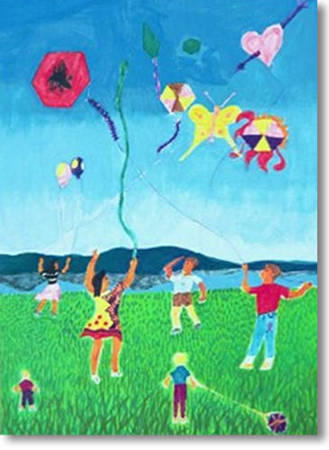Culture shock is divided into five stages. Each stage can be long standing or appears only under certain conditions. It is important to realize that culture shock is a perfectly normal condition which affects persons differently, just as grief, shock and other pressures in life. Some people show stronger reactions than others and not all experience all the five stages of culture shock.
THE FIRST STAGE is often called the honeymoon stage. It is characterized by tension and expectations. While it is going on, people enjoy the excitement that arises from being in a new place where everything is interesting. Some people never leave this initial stage of the exitement that goes along with being abroad. They are constantly experiencing a mild ecstacy and behave like eternal tourists: travel to new and interesting places, make friends only with their fellow countrymen and retain their old way of living. For most people however, the honeymoon passes by and they enter into the second and most difficult stage of the culture shock.
THE SECOND STAGE is the actual shock. We experience that with our students in the Reception Department. Therfore it will be discussed more thoroughly than the other stages.
It can be characterized with loss of courage and general discomfort. Changes in character occur, depression, lack of self-confidence and irritation, people become more vulnerable and prone to crying, more worried about their health, suffer from headache, bad stomach and complaint about pain and allergy. Difficulties with concentration often occur and reduce the ability to learn a new language. These factors increase the anxiety and the stress.
In the following period, the self-awareness dissolves and people have trouble with solving simple problems. Conversations on this stage are about things that can not be bought, what you must get along without, and everything that the people in the new country do wrong (which means “differently”). This stage can be characterized with escape, because in this period you always think of returning to the old country.
People tend to regard ones own culture as the only way to do the things. This attitude has been called „ethnocentrism“. That is the belief that ones own culture, race and nation is the navel of the world. Individuals identify with their own group and its habits. All critical remarks are regarded as a provocation to the individual just as the group. “If you criticize me, you are criticizing my country, if you criticize my country, you are criticizing me.”
Therefore people often show hostile and aggressive resistance against the host country on the second stage of the culture shock. This hostility comes from natural difficulties that a family or individuals run into in the adjustment process. „I feel terribly in the new country, there must be something terribly wrong here“!!!
There are problems in school, difficulties with language, trouble with lodging and employment as well as the fact that the people in the host country just don’t care about these problems or don’t seem to understand them. The result is aggressiveness and discomfort because the people don’t seem like foreigners at all.
Therefore it is important to understand culture shock and what is going on in relations between people. It is important to consider carefully the conduct toward people suffering from culture shock. In the beginning, people are often well received, but when time passes and the novelty disappears, the attitude often turns into indifference or dislike which immigrants experience as hostility. Thus aggressive hostility can escalate on both sides.
Instead of regarding the difficulties in a cultural context, people speak about these problems as if they were specially invented by the host country, in order to get the visitor into a trouble. Under such circumstances, circulating stereotypes emerge, which can lead to collisions if people doesn’t practice tolerance. “These Icelanders”, or “these immigrants” are so and so…….!
THE THIRD STAGE of culture shock is characterized with one’s plunging into new ways of living. With patience, it is possible to reach this stage by the end of the first year. Key aspects in a new culture are being learned and the earlier chaos and lack of direction seldom appears. Relations with the native population are initiated, such as neighbours and workmates or schoolmates. The vocabulary and pronunciation is being learned. Instead of standing outside and watching the culture with critical eyes, people plunge into the life of the new country.
THE FOURTH STAGE is the final stage of the assimilation, characterized with full participation in the way of life in the new country. People seldom think of “them” and “us”. They have assimilated to life, regarding both emotions and general activities and life just as easy as before moving.
THE FIFTH STAGE: Long after people have moved back to the homeland, something unexpected happens. They experience the fifth stage of the culture shock. It is called a reverse culture shock or returning shock, and appears after the return home again. The homeland is not comfortable any more because people have been away from home for a long time and have become comfortable with customs and habits belonging to a new lifestyle. Much has changed and it takes some time to get used to way of life, gestures and symbols of one’s own culture.
